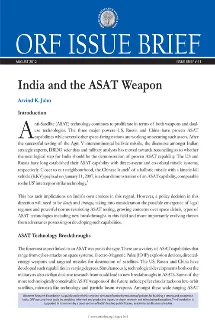Anti-Satellite technology continues to proliferate in terms of both weapons and dualuse technologies. The three major powers–US, Russia and China–have proven ASAT capabilities while several other space-faring nations are working on securing such assets. After the successful testing of the Agni V intercontinental ballistic missile, the discourse amongst Indian strategic experts, DRDO scientists and military analysts has moved towards reconciling as to whether the next logical step for India should be the demonstration of proven ASAT capability. The US and Russia have long established their ASAT capability with direct-ascent and co-orbital missile systems, respectively. Closer to our neighbourhood, the Chinese launch of a ballistic missile with a kinetic-kill vehicle (KKV) payload on January 11, 2007, is a clear demonstration of an ASAT capability, comparable to the US’ interceptor strike technology.
This has tacit implications on India’s own choices in this regard. However, a policy decision in this direction will need to be timely and strategic, taking into consideration the possible emergence of legal regimes and powerful norms restricting ASAT testing, growing concerns over space debris, types of ASAT technologies including new breakthroughs in this field and more importantly evolving threats from adversaries possessing or developing such capabilities.
The foremost aspect linked to an ASAT weapon is the type. There are a variety of ASAT capabilities that range from cyber-attacks on space systems, Electro-Magnetic Pulse (EMP) explosion devices, directedenergy weapons and targeted missiles for destruction of satellites. The US, Russia and China have developed such capabilities in varying degrees. Simultaneously, technological developments both on the military as also civilian dual-use research front could lead to new breakthroughs in ASATs. Some of the more technologically conceivable ASAT weapons of the future include pellet cloud attacks on low-orbit satellites, microsatellite technology and particle beam weapons. Amongst these wide ranging ASAT echnologies, cyber weapons and laser blinding do not have any lasting effect on the satellite system. Missile technology, on the other hand, has the ability to inflict permanent damage to the satellite system. Therefore, this ASAT weapon is likely to be the most potent military tool for the armed forces to possess over the next few decades, notwithstanding a revolutionary technological breakthrough. The proliferation of ballistic missile technology will further accentuate this trend.
However, what is necessary is not just the acquisition of the capability but a demonstration of the same, in the interest of ensuring the required degree of deterrence against potential adversaries. It is widely speculated that the US ASAT test in 2008 was in retaliation to the Chinese test in the previous year, even though the former already has a well established reputation in terms of this capability. India has to take into consideration Chinese postures on ASATs, especially following its move of laser blinding US satellites in 2006 with a kinetic kill ASAT in 2007. By doing so, irrespective of international criticism, China proved its capability to effectively execute ASAT attacks. Keeping in mind its own military calculations, India needs to firmly establish credibility in ballistic missile type ASATs––even a one-time demonstration should be sufficient.
The views expressed above belong to the author(s). ORF research and analyses now available on Telegram! Click here to access our curated content — blogs, longforms and interviews.

 PDF Download
PDF Download



 PREV
PREV


